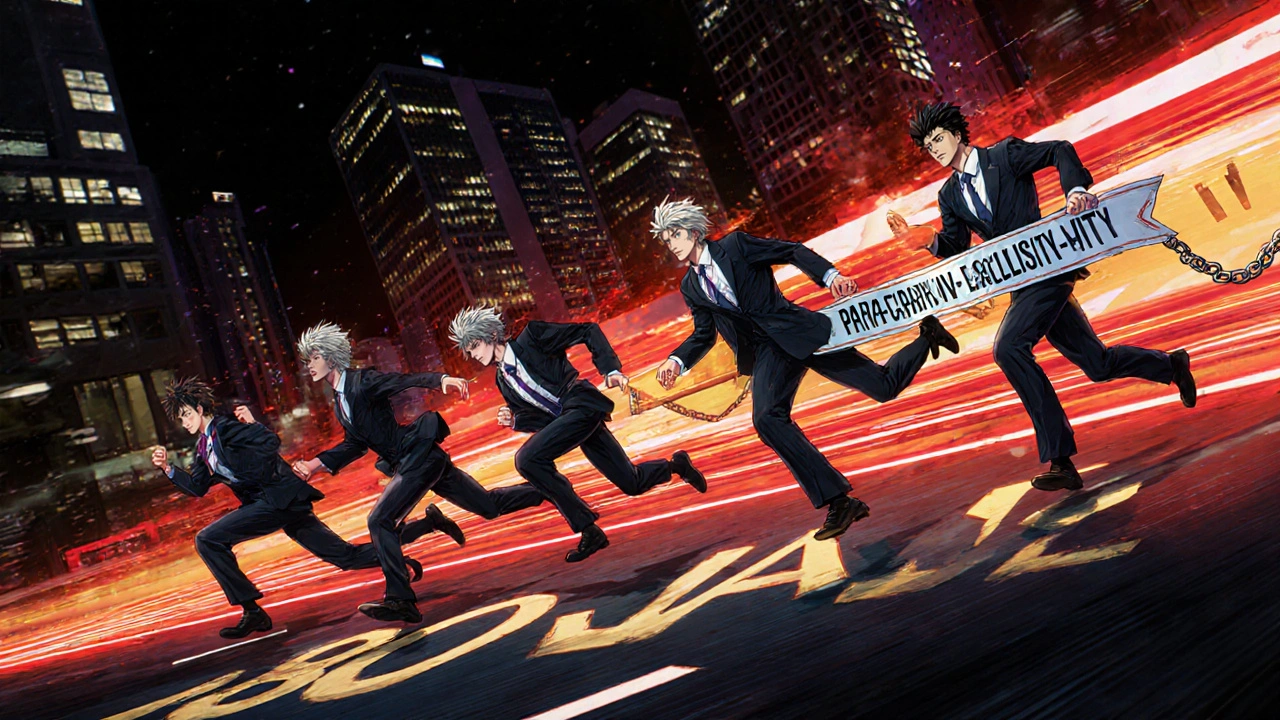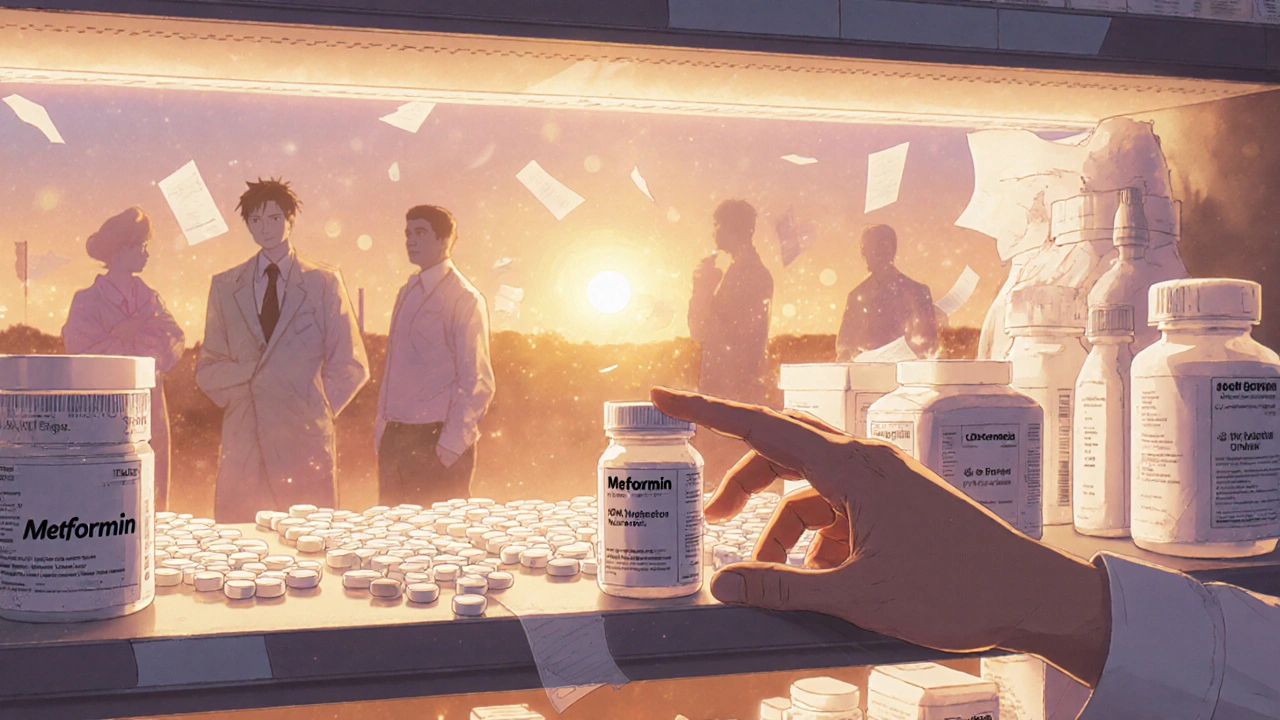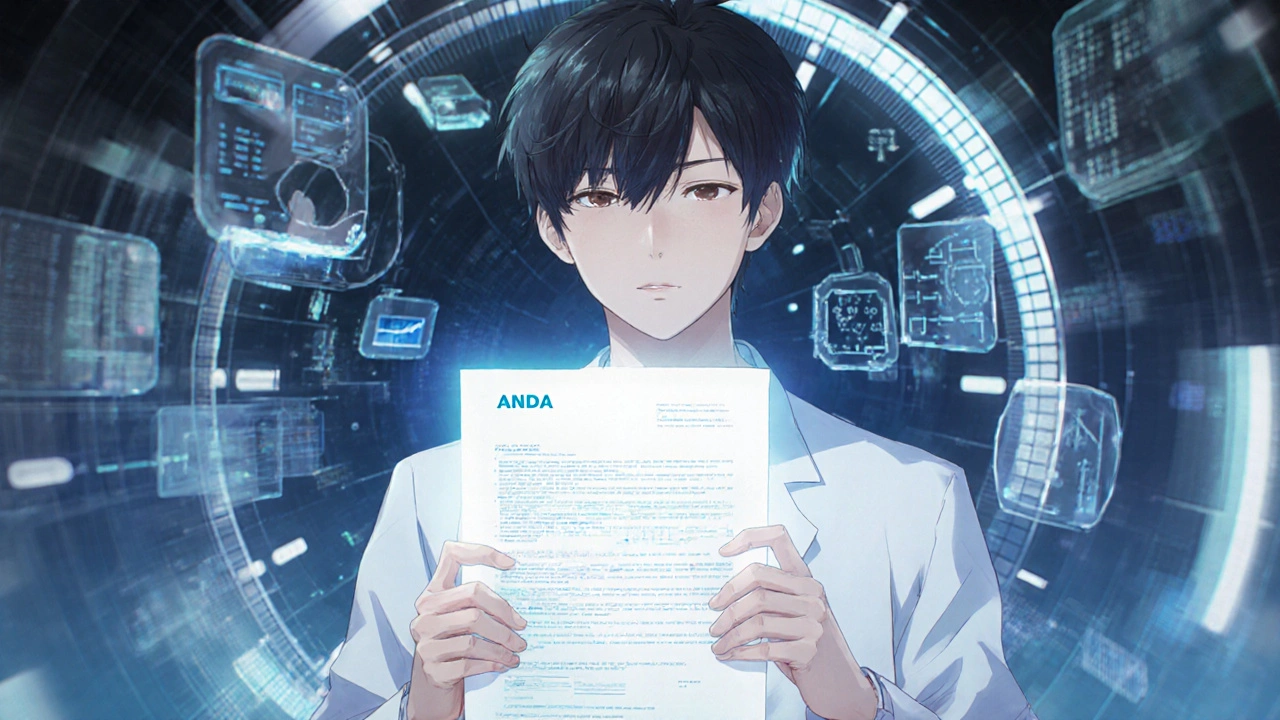When you pick up a bottle of generic ibuprofen at your local pharmacy, it costs a fraction of the brand-name version. But have you ever wondered how that cheap pill made it from a lab in India or New Jersey to your hands? It didn’t just appear on the shelf. There’s a long, tightly regulated journey behind every generic drug - one that starts with a document called an ANDA and ends with a pharmacist handing you a prescription. This is how generic drugs really get from approval to your medicine cabinet.
What Exactly Is an ANDA?
ANDA stands for Abbreviated New Drug Application. It’s not a full drug application like the one brand-name companies file. Instead, it’s a shortcut approved by Congress in 1984 under the Hatch-Waxman Act. The idea was simple: if a drug’s patent has expired, why should another company spend $2 billion and 15 years testing the same medicine from scratch? The ANDA lets generic manufacturers prove their version works just as well - without repeating every clinical trial.
To get approval, a generic company must show the FDA that their product has the same active ingredient, strength, dosage form, and route of administration as the original brand. They also have to prove bioequivalence - meaning the drug gets into your bloodstream at the same rate and amount as the brand. This is usually done with a small study of healthy volunteers. No animal testing. No multi-phase human trials. Just solid chemistry and solid science.
The FDA approves over 800 generic drugs each year. As of 2023, nearly 90% of all prescriptions filled in the U.S. were for generics. That’s more than 6 billion prescriptions annually. And the savings? Around $313 billion a year for patients and insurers.
The Submission Process: Paperwork That Can Take Years
Filing an ANDA isn’t just filling out a form. It’s a massive package of technical data. The FDA requires detailed chemistry, manufacturing, and controls (CMC) documentation. This includes every step of how the drug is made - from the raw ingredients to the final tablet. Even the color of the pill matters. If the brand uses red dye, the generic has to match it unless there’s a safety reason not to.
Everything must be submitted electronically through the FDA’s Electronic Submissions Gateway. The application must also include proposed labeling that matches the brand’s - except for minor changes like the manufacturer’s name or patent disclaimers. If the label says “take with food,” the generic must say the same thing.
Here’s the catch: about 40% of first-time ANDA submissions get rejected. The FDA sends back a Complete Response Letter listing every missing piece or flaw. Common reasons? Incomplete bioequivalence data, inconsistent manufacturing processes, or labeling errors. On average, companies need 1.7 rounds of review before approval. That’s why many now schedule pre-ANDA meetings with the FDA - a chance to get feedback before spending millions on a submission that might fail.
Patents, Exclusivity, and the Race to Be First
Generic companies don’t just wait for patents to expire. They watch them like hawkers at a stock market. When a brand-name drug’s patent is about to end, multiple generic makers scramble to file their ANDA - especially if they include a Paragraph IV certification. That’s a legal notice saying the patent is invalid or won’t be infringed.
If you’re the first to file a Paragraph IV ANDA, you get 180 days of exclusive rights to sell your version. No other generic can enter the market during that time. That’s a huge incentive. In 2022, six companies filed ANDAs on the same day for apixaban (the generic for Eliquis), all hoping to win that 180-day window. Legal battles often follow. Some cases take years to resolve, delaying the drug’s release.
That’s why the first-to-file race is so intense. A single generic can capture 80% of the market if it hits shelves first. But if you’re second, you’re competing against a cheaper version that’s already in every pharmacy.

Approval Doesn’t Mean Availability
Getting FDA approval is only half the battle. Many manufacturers think once the green light comes, the drug will hit shelves immediately. It doesn’t. There’s a gap - often 3 to 6 months - between approval and actual availability.
Why? Three big reasons:
- Scaling up production - A lab batch is one thing. Making 500,000 bottles a week for nationwide distribution is another. Facilities must prove they can maintain quality at commercial scale. That takes 60 to 120 days.
- Getting on pharmacy formularies - Pharmacy Benefit Managers (PBMs) like Express Scripts and OptumRx control which drugs insurers cover and at what price. They demand steep discounts - often 20% to 30% deeper than what the manufacturer expected. If you don’t agree to their terms, your drug won’t be listed. A 2022 survey found that 78% of generic manufacturers spent more time negotiating with PBMs than they did preparing their ANDA.
- Distribution logistics - Once the drug is made and priced, it has to get to pharmacies. That means working with wholesalers like McKesson, Cardinal Health, and AmerisourceBergen. Each one has its own system for adding new products. Integrating a new generic can take 15 to 30 days.
Take the generic EpiPen. It got FDA approval in August 2019. But it didn’t show up on pharmacy shelves until March 2020. Why? Months of back-and-forth with PBMs and distributors. The drug was ready. The market wasn’t.
How Fast Does It Actually Get to the Shelf?
On average, it takes 112 days from FDA approval to the first retail dispensing. But that number varies wildly.
Simple pills - like metformin or lisinopril - move faster. Cardiovascular generics average just 87 days. Why? They’re easy to make, stable, and in high demand. PBMs prioritize them because they’re cost-effective and widely used.
Complex drugs take longer. Inhalers, injectables, and topical creams are harder to replicate. The FDA considers them “complex generics.” They require more testing, stricter controls, and longer reviews. These can take 145 days or more to reach shelves. In 2023, only 65% of complex generic ANDAs were approved on the first try - compared to 85% for simple tablets.
And it’s not just about time. Placement on the pharmacy formulary matters. Drugs on Tier 1 (preferred) get 75% of prescriptions within six months. Tier 2 (non-preferred) get only 35%. That’s why pricing and negotiations are just as important as approval.

Who Benefits - And Who Pays?
The system works because everyone wins - except maybe the brand-name companies.
Patients save money. A typical generic costs 80% to 85% less than the brand. Over the past decade, generics have saved the U.S. healthcare system over $1.67 trillion.
Insurers and PBMs benefit too. Lower drug costs mean lower premiums and better profit margins.
Even the FDA wins. The Generic Drug User Fee Amendments (GDUFA) let the agency collect fees from manufacturers to fund faster reviews. GDUFA III, launched in 2023, is pushing for real-time application processing and better communication between the FDA and applicants. That means fewer delays and more transparency.
But there’s pressure. Generic drug prices have dropped 4.7% per year since 2015. Some manufacturers are leaving the market because margins are too thin. Others are shifting to complex generics, where competition is lower and pricing is more stable.
What’s Next?
The future of generics is changing. More drugs are becoming complex - think patches, nasal sprays, and long-acting injections. These are harder to copy, but also more profitable. The FDA has created a special committee just to handle them.
Artificial intelligence is starting to play a role too. Some companies are using AI to model bioequivalence and predict manufacturing issues before they happen. Early results show it could cut ANDA preparation time by 25% to 30%. But regulators are cautious. They want proof - not predictions.
Also, more generics are being made overseas. The FDA inspects thousands of foreign facilities each year. Quality concerns remain, especially with raw materials from countries with less oversight. The agency is tightening rules on supply chain transparency.
By 2028, experts predict 93% of all prescriptions will be for generics. That’s up from 90% today. The demand is there. The system is built. But the journey from ANDA to shelf? It’s still long, complicated, and fiercely competitive.
If you’re wondering why your generic drug isn’t available yet - it’s not because the pharmacy forgot to order it. It’s because the system, though efficient, is still made of people, paperwork, and profit margins. And sometimes, even the cheapest pill takes time to arrive.
What is an ANDA and why does it matter for generic drugs?
An ANDA, or Abbreviated New Drug Application, is a regulatory submission to the FDA that allows generic drug manufacturers to prove their product is bioequivalent to a brand-name drug without repeating costly clinical trials. It matters because it’s the legal pathway that lets low-cost generics enter the market, saving patients billions each year. Without the ANDA process, most generic drugs wouldn’t be available at all.
How long does it take to get a generic drug from ANDA approval to the pharmacy shelf?
On average, it takes about 112 days from FDA approval to first retail dispensing. But this varies. Simple pills like metformin can reach shelves in as little as 87 days, while complex products like inhalers or topical creams may take 145 days or more. Delays often come from scaling production, negotiating with pharmacy benefit managers, or integrating the drug into wholesale distribution systems.
Why do some generic drugs cost more than others?
Price differences come down to competition and complexity. If multiple companies make the same generic, prices drop fast. But if only one or two manufacturers supply it - especially for complex drugs like injectables or patches - prices stay higher. Also, drugs on Tier 1 formularies (preferred by insurers) get better pricing through rebates, while those on Tier 2 or 3 may cost more at the counter.
What’s the difference between a generic and a brand-name drug?
The active ingredient is identical. So is the strength, dosage form, and how it works in your body. The only differences are in inactive ingredients (like fillers or dyes), packaging, and price. Generics must prove bioequivalence to the brand - meaning they deliver the same amount of medicine into your bloodstream at the same rate. That’s why they’re just as safe and effective.
Why do some generic drugs not show up on my insurance plan?
It’s not about the drug - it’s about contracts. Pharmacy Benefit Managers (PBMs) decide which generics are covered and at what tier. If the manufacturer didn’t offer a deep enough discount, or if the PBM already has a preferred generic, your plan may not cover it - or may charge you more. You can ask your pharmacist for alternatives or request a formulary exception from your insurer.
Are generic drugs made in the same quality facilities as brand-name drugs?
Yes. The FDA inspects all manufacturing facilities - whether they make brand-name or generic drugs - using the same standards. Many generic manufacturers use the same plants as brand-name companies. In fact, over half of all generic drugs sold in the U.S. are made by companies that also produce brand-name versions. The FDA conducts thousands of inspections each year to ensure quality, regardless of the drug’s label.
